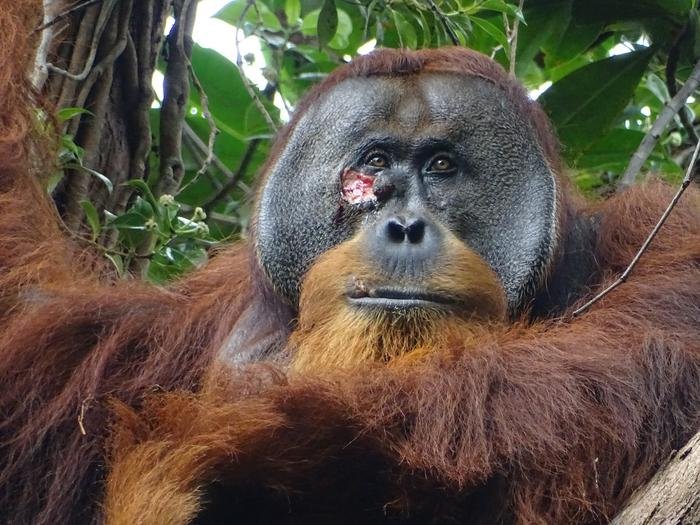Wild Orangutan Used Plant as Pain Reliever
/By Pat Anson, PNN Editor
Humans have used natural remedies like cannabis, kratom and willow trees for thousands of years for pain relief. But other primates may have beaten us to the punch when it comes to using plants as medicine.
That’s one of the theories emerging after a wild orangutan in Indonesia was observed using a plant to help heal a facial wound. The orangutan, named Rakus by scientists, lost a chunk of flesh below his right eye, apparently during a fight with another male orangutan.
A wound like that could easily become infected in the damp rain forests of Sumatra, but Rakus had other ideas.
Scientists observed Rakus rubbing sap from a flowering vine called liana (Fibraurea tinctoria) directly on the wound and then chewing on its leaves to create a paste that he applied over the wound as a poultice.
Scientists say the wound never became infected and within a few days was completely healed.
Since liana leaves are not typically eaten by orangutans as food, it’s believed to be the first time that a big ape was observed self-medicating.
“The behavior of Rakus appeared to be intentional as he selectively treated his facial wound on his right flange, and no other body parts, with the plant juice. The behavior was also repeated several times, not only with the plant juice but also later with more solid plant material until the wound was fully covered. The entire process took a considerable amount of time,” says Isabelle Laumer, PhD, a researcher at the Max Planck Institute of Animal Behavior in Germany.
“Interestingly, Rakus also rested more than usual when being wounded. Sleep positively affects wound healing as growth hormone release, protein synthesis and cell division are increased during sleep.”
Rakus’ behavior raises several intriguing questions. Did he discover the healing powers of lianas on his own? Or was it something he learned from other orangutans and was passed down, from one big ape to another, over generations?
Indigenous people in Southeast Asia also use lianas as medicine. Are the plant’s medicinal properties something they learned while watching orangutans?
“This and related liana species that can be found in tropical forests of Southeast Asia are known for their analgesic and antipyretic (fever reducing) effects and are used in traditional medicine to treat various diseases, such as malaria,” said Laumer, who reported her findings in the journal Scientific Reports.
Like kratom, the pain-relieving effects of lianas comes from chemical compounds called alkaloids, which act on opioid receptors in the brain. The alkaloids in lianas also have antibacterial, anti-inflammatory, anti-fungal, and antioxidant properties that promote wound healing. In Borneo, native people have even used Fibraurea tinctoria to treat diabetes.
“It shows that orangutans and humans share knowledge. Since they live in the same habitat, I would say that’s quite obvious, but still intriguing to realize,” said co-author Caroline Schuppli, PhD, a primatologist at the Max Planck Institute.
“As forms of active wound treatment are not just human, but can also be found in both African and Asian great apes, it is possible that there exists a common underlying mechanism for the recognition and application of substances with medical or functional properties to wounds and that our last common ancestor already showed similar forms of ointment behavior.”
We only know about Rakus because he lives in an animal sanctuary where orangutans are closely monitored. In 21 years of observation, scientists there have not seen any other orangutans treat their wounds with lianas, although that may be due to the fact that they are solitary animals who spend most of their lives in trees and injured ones are rarely seen.
Schuppli says Rakus may have learned how to treat his wound from his mother, by observing other orangutans, or through “individual innovation.” Orangutans eat hundreds of different fruits and plants, and it’s possible Rakus just stumbled onto the right one at the right time.
“As Fibraurea tinctoria has potent analgesic effects, individuals may feel an immediate pain release, causing them to repeat the behavior several times,” she said.




